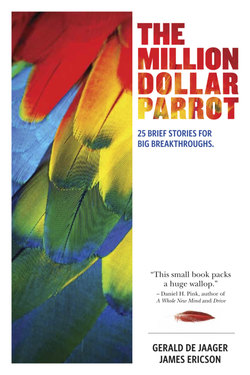Читать книгу The Million Dollar Parrot: 25 Brief Stories for Big Breakthroughs - Gerald de Jaager - Страница 5
На сайте Литреса книга снята с продажи.
ОглавлениеThe Baboon Reflex
Fear makes animals, and people, do unproductive things.
Robert Sapolsky is a brilliant scientist with a knack for showing what humans can learn from animal behavior. His bestselling books include Why Zebras Don’t Get Ulcers and A Primate’s Memoir.13
A Stanford professor and winner of a MacArthur “genius” award, he conducts extensive first-hand research among baboons in Africa—he’s been going there for more than 20 years. Here’s a story he’s told about baboon behavior:
When baboons hunt together they’d love to get as much meat as possible, but they’re not very good at it. The baboon is a much more successful hunter when he hunts by himself than when he hunts in a group because they screw up every time they’re in a group. Say three of them are running as fast as possible after a gazelle, and they’re gaining on it, and they’re deadly. But something goes on in one of their minds—I’m anthropomorphizing here—and he says to himself, “What am I doing here? I have no idea whatsoever, but I’m running as fast as possible, and this guy is running as fast as possible right behind me, and we had one hell of a fight about three months ago. I don’t quite know why we’re running so fast right now, but I’d better just stop and slash him in the face before he gets me.” The baboon suddenly stops and turns around, and they go rolling over each other like Keystone cops and the gazelle is long gone.14
Anything like that ever happen in your organization, or your life? Forgetting the team’s goal and worrying instead about who might be gaining on you? These baboons had a goal and they had motivation to achieve it that’s just about as powerful as any motivation could be: food and survival. In today’s terms, they were “highly incented.” But fear undermined them nonetheless.
Makes you think of W. Edwards Deming’s famous pronouncement, “Drive out fear, so that everyone may work effectively for the company,”15 doesn’t it? “The economic loss from fear is appalling,” Deming said.16
Back when AOL acquired Time Warner in 2001 and all the experts were bowing down to this brilliant exercise in the most current business buzzword of the day, “synergy”—that was before the stock price lost 80 percent of its value and the whole enterprise eventually fell apart—one commentator saw the baboons. Under the headline “Reminder to Steve Case: Confiscate the Long Knives,” Wired columnist Frank Rose cautioned that Time Warner had become “a corporate version of the Holy Roman Empire: a loose confederation of fiefdoms that are as likely to be at war with one another as with outsiders. Infighting can break out at any level.”17
Was it a long history of fear and jealousy that created that disastrous culture? Hard to know for sure, but what do you think?
The fear center in the human brain has a hair trigger. An experiment shows how exceptionally susceptible to fear we are. Brain scientists wired up some people as they were watching the 2006 Super Bowl, in order to see which brain parts were activated as the commercials were viewed. Federal Express introduced a commercial in which a caveman is reprimanded by his caveman boss for not using Federal Express to ship an important package. As the reprimanded caveman walks away from the encounter, he is stepped on and crushed by a dinosaur.
Most people might describe this ad as “funny” or “cute,” not frightening, but to our brains, it’s an entirely different matter. More particularly, it’s deeply alarming to the brain’s fear center, the amygdala, which seeks out danger and then issues warnings throughout the body’s systems. Here’s a chart of the amygdalar activity that those Super Bowl researchers measured among the viewers of that FedEx commercial, up to and just past the moment when the caveman gets crushed by the dinosaur (as indicated by the arrow):
18
Fear is almost always with us, even when we’re unaware of it. It might be easy to nod in wise agreement with the management shibboleth, “People don’t dislike change; they just dislike being changed,” but there’s only a small amount of truth in that. Acknowledging the sharp, constant, often-hidden reality of fear is a crucial first step toward hushing the ancient brain centers that can turn even our best intentions into disappointments that only look like slapstick comedies to those who are not living them.
One Leader’s Fear
Former publishing executive James Autry has written ten books about the human side of leadership. He begins his book Life & Work with a story that includes the following exchange between him and a friend:19
“Do you ever get the feeling that one day they are going to come into your office and say, ‘Okay, Autry, we found out about you’?”
“Yes, yes,” I said, almost shouting. “I frequently get that feeling. You, too?”
He nodded, and we both began to laugh. “You know what this tells us,” he continued.
I knew, but I could not find the exact words. He did it for me: “There are no big boys, only us little boys.”
